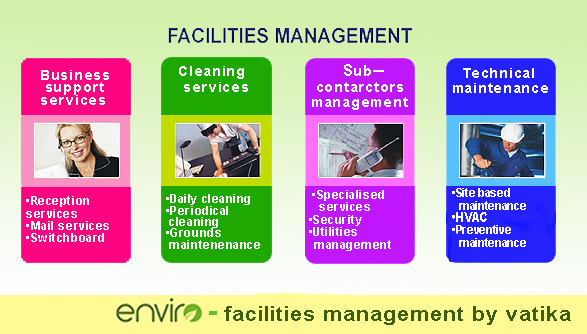Understanding the Vital Concepts of Facility Management for Modern Services
Understanding the Vital Concepts of Facility Management for Modern Services
Blog Article
The Necessary Overview to Facility Management: Strategies for Success
Facility administration plays a critical function in the total success of an organization, serving as the foundation that supports efficiency, security, and performance. The subtleties of effective facility administration expand past plain logistics and require an extensive understanding of both measurable and qualitative metrics.
Recognizing Facility Management
What constitutes efficient facility management? Efficient facility management encompasses the control of various organizational functions to guarantee that developed atmospheres are risk-free, effective, and helpful to performance. Facility Management. It incorporates the concepts of organization, style, and design administration to produce a seamless operational circulation within a company
Trick aspects of center administration include space preparation, upkeep management, and conformity with wellness and security policies. Space planning concentrates on maximizing making use of physical resources to support business goals, while maintenance management makes certain that centers are kept in optimal problem, making best use of life-span and minimizing operational prices. Conformity with governing and lawful requirements is crucial, as it safeguards the company versus potential responsibilities and improves its credibility.
Furthermore, reliable facility monitoring depends on the strategic use innovation, such as Structure Administration Systems (BMS) and Computer-Aided Center Management (CAFM) devices. These technologies promote real-time tracking of structure systems and improve upkeep processes. Inevitably, an extensive approach to facility monitoring not only promotes operational effectiveness but additionally fosters a favorable environment for workers and visitors alike, driving overall business success.
Key Methods for Optimization
Maximizing facility monitoring requires a calculated strategy that aligns functional exercise with organizational purposes. To achieve this, the very first crucial strategy is the execution of integrated technological remedies. Utilizing sophisticated software program systems permits real-time tracking of center procedures, facilitating data-driven decision-making and enhancing general performance.
Secondly, regular analyses of facility efficiency are vital. Carrying out regular inspections and audits enables facility supervisors to recognize locations that require improvement, making sure that sources are alloted properly. This proactive approach helps in reducing downtime and improving solution shipment.
An additional essential strategy is fostering collaboration across departments. By encouraging open communication between groups, center supervisors can much better straighten their approaches with organization objectives, bring about boosted functional harmony. Furthermore, engaging staff in training programs promotes a culture of accountability and boosts their capacity to add to optimization initiatives.
Enhancing Security Procedures
Enhancing safety protocols is essential for creating a safe and secure setting within facilities. A comprehensive safety and security method not only safeguards workers and visitors but also boosts functional effectiveness. To accomplish this, facility supervisors need to carry out regular threat evaluations to make sure and identify possible dangers that suitable measures remain in location.
Educating and education and learning are important components of reliable security protocols - Facility Management. Staff members ought to receive ongoing training in emergency situation treatments, devices handling, and individual protective measures. Routine drills, such as fire evacuations or lockdown treatments, foster familiarity and readiness among team
Furthermore, clear interaction channels have to be established to report safety worries quickly. This consists of creating an obtainable platform for staff members to voice prospective hazards or occurrences without fear of . Moreover, leveraging technology can improve precaution; as an example, executing security systems and access controls assists check facility tasks and limit unauthorized entrance.
Lastly, compliance with regional guidelines and industry standards is non-negotiable. Routine audits and evaluations of safety and security methods guarantee positioning with existing regulations and best practices. By prioritizing these strategies, center supervisors can grow a society of safety that safeguards all stakeholders and eventually adds to the company's success.
Improving Workplace Environment

Ergonomic considerations are vital to lessen physical stress and discomfort. Facility Management. This includes offering adjustable furnishings, proper lighting, and adequate space for movement. These adjustments can bring about lowered absence and boosted task fulfillment
Looks play a crucial function fit the workplace atmosphere. Making use of shade psychology, all-natural illumination, and greenery can cultivate a stimulating and inviting setting. Thoughtfully designed rooms can enhance creative thinking and enhance overall health.
In addition, motivating employee involvement website with inclusive decision-making procedures can improve the sense of possession and belonging. Gathering feedback on office improvements and entailing employees in the design procedure can cause a more customized environment that fulfills their needs.
Finally, advertising well-being efforts, such as wellness programs and leisure areas, can further add to a helpful workplace culture. By concentrating on these methods, facility supervisors can efficiently boost the workplace setting, driving both worker satisfaction and business success.
Measuring Success in Facilities
Determining success in center administration calls for an extensive strategy that assesses both measurable and qualitative metrics. Measurable metrics generally consist of crucial performance indicators (KPIs) such as area utilization get more info rates, power consumption, maintenance prices, and occupancy levels. These metrics give a clear picture of functional performance and financial performance, permitting facility managers to determine locations for improvement and criteria versus sector standards.
Qualitative metrics, on the other hand, concentrate on customer complete satisfaction and worker involvement. Surveys and feedback systems can determine how well the facilities satisfy the requirements of owners, helping to evaluate the general office setting. This facet is essential, as a pleased labor force is commonly connected to increased productivity and retention rates.
To efficiently determine success, center supervisors must additionally take into consideration incorporating technology, such as building management systems and data analytics tools, to collect and evaluate appropriate data. Routinely evaluating both collections of metrics permits a more balanced view of performance and informs strategic decisions. Ultimately, an effective center management strategy depends upon a commitment to continuous renovation, making certain that both functional performances and individual fulfillment are prioritized.
Final Thought

Facility administration plays a critical function in the total success of an organization, offering as the foundation that supports safety and security, productivity, and effectiveness.Secret components of center management include room preparation, maintenance management, and compliance with wellness and safety and security regulations.Additionally, reliable center monitoring relies on the tactical use of innovation, such as Structure Monitoring Systems (BMS) and Computer-Aided Facility Management (CAFM) tools. Eventually, a detailed strategy to center monitoring not just advertises functional performance but also fosters a positive environment for visitors and employees alike, driving overall organizational success.
Ultimately, a successful facility management strategy pivots on a dedication to continuous improvement, ensuring that both functional effectiveness and customer complete satisfaction are focused on.
Report this page